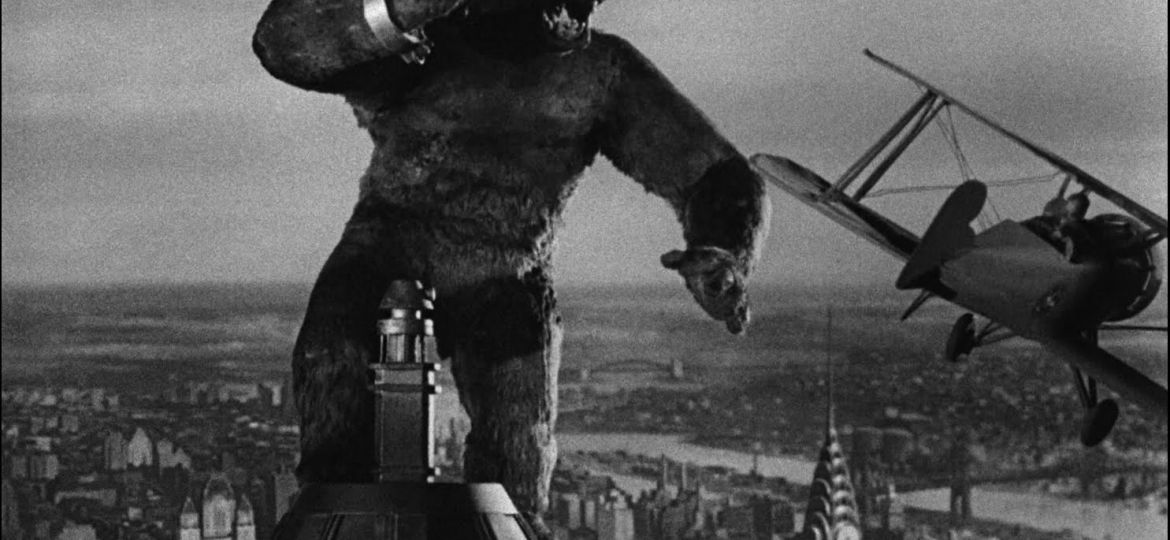
Welcome back to this year’s penultimate installment of Shocktoberfest, and today’s featured monster is one of the all-time greats. Unlike Cthulhu, this one had the ability to terrorize audiences everywhere with his size and strength but also had a tragic and lonely side to his character which also made audiences care about him. He’s the Eighth Wonder of the World whose likeness has been remade and spun-off too many times to count: King Kong.
He was created by writer, director and former aviator Merian C. Cooper (oddly enough, his work was contemporary with Howard Hughes’ as well.) Being one who loved adventure, his trip to Komodo Island inspired him so much that he wanted to tell a story of a rampaging giant gorilla and even considered capturing a real gorilla from the Congo and have it fight a Komodo dragon. While he never got to try this, his idea later was used in his film with a Tyrannosaurus Rex fighting the mighty ape.
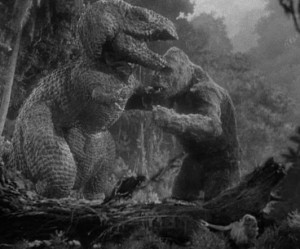
Cooper was also very fond of strong sounding words beginning with the letter “K.” He said that some of his favorite words were Kodiak, Kodak and, of course, Komodo, so when thinking of a name for his gorilla, he swapped the “C” in Congo with a “K” and simply shortened it to Kong because he thought it rang with an air of mystery. This mysteriousness was meant to emulate the singular name of characters like Dracula and Frankenstein, and with delaying the appearance of Kong until later in the movie, that only added to build-up and romanticism of his character.
Originally, the title for the movie was simply called The Beast, but the executives at RKO weren’t impressed with that title because they felt it was too bland. They suggested names like Kong: King of Beasts, Kong: The Jungle King and Kong: The Jungle Beast, but Cooper didn’t like any of those titles either because he wanted the focus to just be on the name, so he eventually simplified the title to Kong. But as we all know, that wasn’t the final title either because Cooper had built a reputation of giving his docudramas one-word titles, and RKO didn’t want audiences to think that they were watching a documentary, Cooper bestowed the title of “King” to Kong in order to differentiate it from his previous works, and the rest is history.
Kong’s story, for those of you who don’t know, is pretty basic. Filmmaker, Carl Denham, takes his cast and crew on location to Skull Island because of a monstrous rumor he’s heard about the island known simply as “Kong,” even though he has no idea what this Kong is. After meeting with the natives, Denham and his crew decline to do business with them after they offer to trade six of their women for his leading actress, Ann Darrow, but later that night when they’re back on board their ship, a group of natives capture Ann and tie her to columns outside their wall as a sacrifice to Kong, who turns out to be a giant gorilla. While in pursuit of Kong, the crew discover that there are other prehistoric creatures living on this island, and when a Tyrannosaurus attempts to eat Ann, Kong kills it by breaking its jaw and subsequently crushing its skull. Denham eventually subdues Kong with a gas bomb and decides to make an even bigger spectacle of Kong by taking him back to New York to be put on display. Once back in New York, Kong is shackled on a stage in front of a large audience, but disturbed by the flash photography from the press, he breaks his chains and escapes into the city in search of Ann, having developed a fondness for her. Once he finds her, he grabs her and climbs atop the Empire State Building. His escape is short-lived after a squadron of military planes attempt to shoot him down. While he’s able to take down some of the planes, he succumbs to his wounds and plummets to his death. Upon finding his corpse in the street, Denham concludes that it wasn’t the airplanes that killed him but “It was Beauty who killed the Beast.”
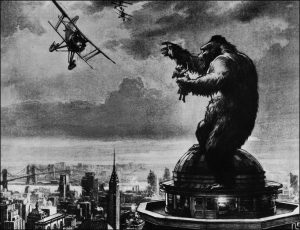
Even though it wasn’t nominated for a single Academy Award, the film was a smash hit that has been regarded as one of the great leaps forward in special effects and was added to the National Film Registry in 1991—58 years after its release. Since then, the film has been remade twice. Once in 1976 and again in 2005.
The 1976 film was a great commercial success and made Jessica Lange a household name in her film debut, but critical response was very mixed and overall has been deemed as not being very good. While it does try to update the story by adding color and having Kong climb atop the World Trade Center towers which were even taller than the Empire State Building, critics found the story and tone to be too campy and silly, lacking the pathos of the 1933 original.
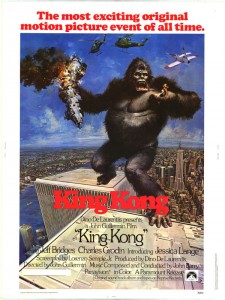
The 2005 version was directed by Peter Jackson just off of his success with The Lord of the Rings trilogy, and he wanted to pay homage to Cooper’s film while making Kong look and move more like a real gorilla. He cast Andy Serkis to play the titular character by tracking his movements and rendering him in CGI format as he had done when Serkis played Gollum. Jackson also did research on zoology and wanted Kong to be a descended species from a real life extinct species of ape known as Gigantopithecus.
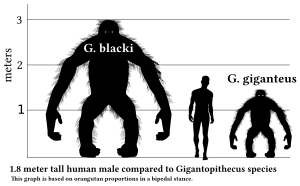
Jackson’s film also goes back to the 1933 setting and is the only Kong film to last more than three hours. With all that extra time, he focused more on the relationship between Kong and Ann, making his search throughout the city for her more understandable and more heartbreaking when he dies trying to protect her. Unlike Cooper’s film which spawned a sequel the same year called Son of Kong, Jackson decided that Kong is the last of his species and growing old as evidenced by his graying fur and battle scars. Where we never really know what Cooper’s Kong was thinking, Jackson slowed things down in order to allow the audience to identify with the beast and feel his loneliness. While not as highly regarded as the original, Jackson’s film was still a great success commercially and critically.
Besides the three major film versions, Kong has been the inspiration for countless other giant ape monsters in comics, video games, movies, cartoons, et cetera, but for brevity’s sake, we’ll look at three examples.
The first comes from the directors of the 1933 film, Merian C. Cooper and Ernest B. Schoedsack, with the 1949 film, Mighty Joe Young. Personally, I think this was their idea of having a King Kong story with a happier ending. Joe is not a wild savage like Kong. He’s a giant pet gorilla whose eventually taken to Hollywood instead of New York, and despite wrecking a lot of havoc in L.A., Joe’s life is spared since he ultimately saves the lives of some children in danger and is allowed to be moved back to Africa safely with his owners.
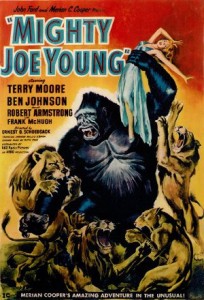
For you Superman fans, you might be familiar with Titano. While he’s a chimpanzee instead of a gorilla, he’s also enormous and very strong, and to Superman’s chagrin, Titano has the ability to emit Kryptonite from his eyes.
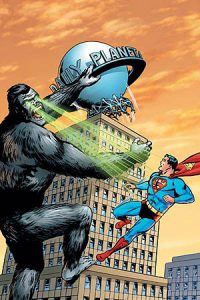
And of course, who could forget the big ape that Mario faces in his video game debut: Donkey Kong. With the success of the original Donkey Kong and Donkey Kong, Jr., this lovable loaf has been given his own long-running series of games and has earned the nickname “DK” from fans and game designers alike.
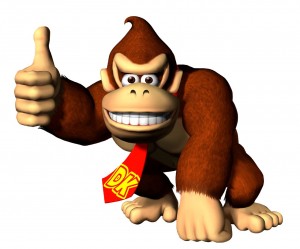
Before I wrap things up, I’d be remiss if I didn’t mention that Kong was doing crossover movies with another classic monster and was re-imagined and given new powers in the 1962 Japanese film, King Kong vs. Godzilla. Not only was this the first time that both characters had been portrayed in color and widescreen, but it also remains as the most commercially successful Godzilla movie to this day.
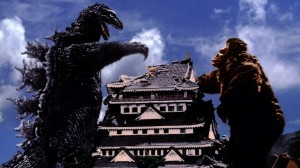
Since his debut in 1933, King Kong has become one of the biggest starts in the monster universe and for good reason. Gorillas have long been associated with strength and virility, so finding one as big as Kong amplifies that symbolism. Yet as much as we fear him, we also pity him because underneath his rough exterior is a lonely and frightened animal who doesn’t understand what’s happening around him and only really wants to be appreciated and validated by anything that will give him the time of day. That’s what made 12 year-old Peter Jackson cry when he first saw Kong fall to his death, and it’s probably what pulled at our heartstrings as well. Kong represents a unique innocence to the monster canon that compels its audience to question what it actually means to be savage. And if you think Kong’s story is done being told, think again. A musical based on the story with the same name debuted in Melbourne, Australia in 2013, and with the success of its run, there are plans for it to be shown in South Korea, Japan, Germany, the Netherlands, the United Kingdom and even the United States in 2015. We also have another movie to look forward to in 2016. While the details haven’t been finalized yet, it will be a prequel to King Kong called Skull Island and will star Loki himself, Tom Hiddleston.
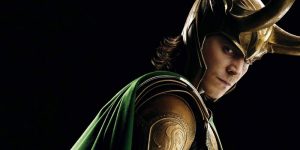
As a fan of Kong, I’m excited to see where this story goes and looking forward to new ways in which this true king of the jungle will create carnage on those who try to put him in his place. Long live the Eighth Wonder of the World!
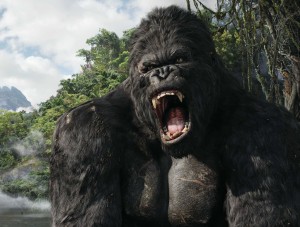







donkey kong… my favorite version of the “king” of the giant gorillas. haha. good stuff!